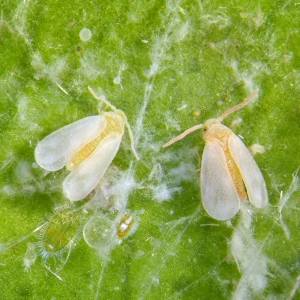Whiteflies are small, winged insects typically white or pale yellow in colour. The most common species in the UK are the greenhouse whitefly, the tobacco whitefly, and outdoors, the brassica whitefly.
Adult whiteflies are about 2mm long with white wings. Their colour makes them easy to spot on most plants. They are very common and can be found on a range of plants outside, including vegetables, honeysuckle, rhododendrons, and other ornamentals.
Identifying Whitefly Damage
Whiteflies are sap suckers and excrete honeydew - you may notice discoloured patches on sections of leaf where they have been feeding.
Leaves can curl, wilt or drop completely as a result of their feeding, and edible produce can be spoiled through sticky honeydew deposits.
Black sooty mould can develop on these sticky leaves which will gradually deprive the plants of light causing further damage or plant death.
Natural predator controls
The natural predator controls for whitefly are parasitic wasps. You can buy two different types of predator wasps depending on whether you are trying to control whitefly in a greenhouse or outdoors. These are:
• Eretmocerus eremicus for outdoor areas.
• Encarsia formosa for greenhouses.

Eretmocerus eremicus
Eretmocerus eremicus is a tiny parasitic wasp and is a very effective predator. It lays its eggs inside the whitefly nymphs, which consume the host from within once hatched, causing their death, and significantly reducing the whitefly population.
A single female adult can parasitise up to 150 pest whitefly larvae.
Encarsia formosa
Encarsia formosa wasp pupae will hatch out into adult female parasitic wasps once the temperatures reach 16°C.
The adult wasps will search for whitefly larvae then parasitise the whitefly and lay an egg inside it, causing it to die. A new parasitic wasp will develop inside the dead whitefly larvae and will eventually emerge to search for more whitefly.
The wasps will also feed on the younger larvae of whitefly in the 1st and 2nd larval stages of development.
How to use biological predator controls for whitefly
These predator parasitic wasps are supplied as pupae on cards. The wasps will have emerged after about a week subject to temperatures.
Simply hang the cards in the affected crops or plants spacing them according to the pack size instructions. Cards should be hung approximately 50cms below the top of the plants.
Wait until all the wasps have emerged from the cards and regularly reintroduce cards throughout the growing season between April and August. Avoid placing them in direct sunlight and try not to touch the pupae.
It is best to use parasitic wasp controls straight away – do not store for more than 24 hours and do not keep pesticides anywhere near live controls.
For further advice or guidance, please contact our technical team on 01522 246491.




